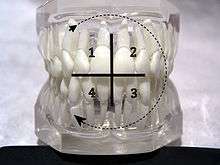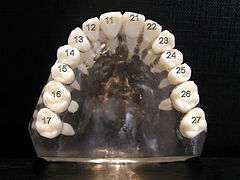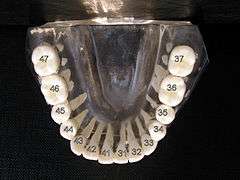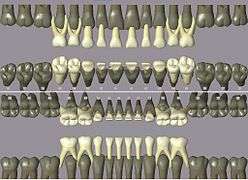Dental notation
Dental professionals, in writing or speech, use several different dental notation systems for associating information with a specific tooth. The three most common systems are the ISO System (ISO 3950, the FDI World Dental Federation notation), Universal Numbering System, and Palmer notation method. The ISO system is used worldwide, and the Universal is used widely in the United States. The ISO System can be easily adapted to computerized charting.

Another system is used by paleoanthropologists.
History
A committee of the American Dental Association (ADA) recommended the use of the Palmer notation method in 1947. Since this method required the use of symbols, its use was difficult on keyboards. As a result, the association officially supported the Universal system in 1968. The World Health Organization and the Fédération Dentaire Internationale officially uses the two-digit numbering system of the FDI system. However, in 1996, the ADA adopted the ISO System as an alternative to the Universal System.
ISO System by the World Health Organization

The International Standards Organization Designation System (ISO System) by the World Health Organization notation system is widely used by dental professionals internationally to associate information with a specific tooth. Based on the Fédération Dentaire Internationale (FDI), it is also known as ISO 3950[1] notation. Thus the ISO System uses a two-digit numbering system in which the first digit represents a tooth's quadrant and the second digit represents the number of the tooth from the midline of the face. For permanent teeth, patient's upper right teeth begin with the number, "1". The upper left teeth begin with the number, "2". The lower left teeth begin with the number, "3". The lower right teeth begin with the number, "4". For primary teeth, the sequence of numbers goes 5, 6, 7, and 8 for the teeth in the upper right, upper left, lower left, and lower right respectively. When speaking about a certain tooth such as the permanent maxillary central incisor, the notation is pronounced “one, one”. Beware of mixing up the teeth in written form such as 11, 12, 13, 14, 15, 16, 17, 18 between the Universal and ISO systems.
For example: retention of a primary molar tooth in the otherwise regular intact lower right jaw, position 5, would be noted as: 41, 42, 43, 44, 85, 46, 47, 48.
 ISO notation upper jaw
ISO notation upper jaw ISO notation lower jaw
ISO notation lower jaw ISO notation primary teeth
ISO notation primary teeth
Permanent Dentition
upper right - 1 upper left - 2
18 17 16 15 14 13 12 11 | 21 22 23 24 25 26 27 28
R --------------------------------------------------- L
48 47 46 45 44 43 42 41 | 31 32 33 34 35 36 37 38
lower right - 4 lower left - 3
Primary Dentition
upper right - 5 upper left - 6
55 54 53 52 51 | 61 62 63 64 65
R --------------------------------- L
85 84 83 82 81 | 71 72 73 74 75
lower right - 8 lower left - 7
I - incisor
C - canine
P - premolar
M - molar |
Palmer notation method
The Palmer notation is a system used by dentists to associate information with a specific tooth. Although supposedly superseded by the FDI World Dental Federation notation, it overwhelmingly continues to be the preferred method used by dental students and practitioners in the United Kingdom.[2] It was originally termed the "Zsigmondy system" after the Hungarian dentist Adolf Zsigmondy who developed the idea in 1861, using a Zsigmondy cross to record quadrants of tooth positions.[3] Permanent teeth (adult) were numbered 1 to 8, and the child primary dentition (also called deciduous, milk or baby teeth) were depicted with a quadrant grid using Roman numerals I, II, III, IV, V to number the teeth from the midline distally. Palmer changed this to A, B, C, D, E.
The Palmer notation consists of a symbol (┘└ ┐┌) designating the quadrant of the tooth and a number indicating the position from the midline. Adult teeth are numbered 1 to 8, with primary teeth indicated by a letter A to E. Hence the left and right maxillary central incisor would have the same number, "1", but the right one would have the symbol, "┘", underneath it, while the left one would have, "└".
Permanent Dentition
upper right - 1x upper left - 2x
8 7 6 5 4 3 2 1 | 1 2 3 4 5 6 7 8
R --------------------------------------------------- L
8 7 6 5 4 3 2 1 | 1 2 3 4 5 6 7 8
lower right - 4x lower left - 3x
Primary Dentition
upper right - 5x upper left - 6x
E D C B A | A B C D E
R --------------------------------- L
E D C B A | A B C D E
lower right - 8x lower left - 7x
I - Incisor
C - Canine
P - premolar
M - molar |
Universal numbering system
Although it is termed "universal numbering system", it is most commonly used in the United States. It is also called the "American system".[4] The uppercase letters A through T are used for primary teeth and the numbers 1 - 32 are used for permanent teeth. The tooth designated "1" is the maxillary right third molar ("wisdom tooth") and the count continues along the upper teeth to the left side. Then the count begins at the mandibular left third molar, designated number 17, and continues along the bottom teeth to the right side. Each tooth has a unique number or letter, allowing for easier use on keyboards.
| Permanent Dentition | |||||||||||||||
|---|---|---|---|---|---|---|---|---|---|---|---|---|---|---|---|
| upper right | upper left | ||||||||||||||
| 1 | 2 | 3 | 4 | 5 | 6 | 7 | 8 | 9 | 10 | 11 | 12 | 13 | 14 | 15 | 16 |
| 32 | 31 | 30 | 29 | 28 | 27 | 26 | 25 | 24 | 23 | 22 | 21 | 20 | 19 | 18 | 17 |
| lower right | lower left | ||||||||||||||
| Primary Dentition | |||||||||||||||
| upper right | upper left | ||||||||||||||
| A | B | C | D | E | F | G | H | I | J | ||||||
| T | S | R | Q | P | O | N | M | L | K | ||||||
| lower right | lower left | ||||||||||||||
| Alternate system for Primary Dentition | |||||||||||||||
| upper right | upper left | ||||||||||||||
| 1d | 2d | 3d | 4d | 5d | 6d | 7d | 8d | 9d | 10d | ||||||
| 20d | 19d | 18d | 17d | 16d | 15d | 14d | 13d | 12d | 11d | ||||||
| lower right | lower left | ||||||||||||||
Notation used by paleoanthropologists
Paleoanthropologists use a system suitable to other primates as well. The upper teeth are denoted I1, I2, C−, Pm3, Pm4, M1, M2, and M3. Left or right has to be specified. The lower teeth are I1, I2, C−, Pm3, Pm4, M1, M2, and M3. The reason the premolars are labeled 3 and 4 is that in earlier primates there were two other premolars between them and the canines.[5]
Letters and numbers system
In this system, also known as alpha-numeric notation, the four quadrants are designated as follows:
- UR - upper right
- UL - upper left
- LR - lower right
- LL - lower left
Within each quadrant, the teeth are numbered as in the Palmer notation: 1-8 for permanent and A-E for deciduous, both starting at the midline. For example, the permanent left maxillary first molar is designated UL6.
To prevent uncertainty or ambiguity, teeth may be indicated using more than one notation, particularly when referring for an extraction; this makes it less likely for the incorrect tooth to be needlessly extracted. For instance, a dentist may give an instruction to "extract the 24 (UL4) upper left first premolar tooth."
References
- ISO 3950:2009 Dentistry — Designation system for teeth and areas of the oral cavity
- Blinkhorn A, Choi C, Paget H (1998). "An investigation into the use of the FDI tooth notation system by dental schools in the UK". Eur J Dent Educ. 2 (1): 39–41. doi:10.1111/j.1600-0579.1998.tb00034.x. PMID 9588962.
- Huszár G (1989). "[The role of the life and works of Adolf Zsigmondy and Ottó Zsigmondy in the history of dentistry][Article in Hungarian]". Fogorv Sz. 82 (12): 357–63. PMID 2689240.
- "Histology: A Text and Atlas by Michael H. Ross • Wojciech Pawlina".
- Gentry Steele and Claud Bramblett (1988). The Anatomy and Biology of the Human Skeleton. pp. 75, 82. ISBN 9780890963265.